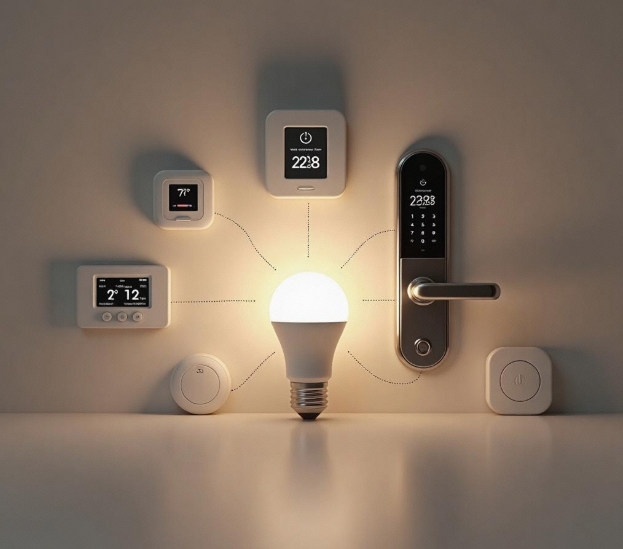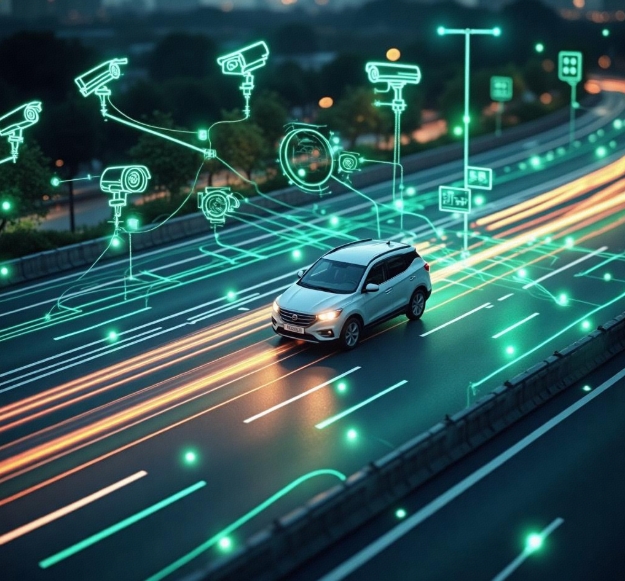Internet of Things Combined with AI: Enhancing the Development of Intelligent Applications
- latest articles
- 1.DApp Development & Customization: Merging Diverse Market Needs with User Experience 2.Analysis of the Core Technical System in DApp Project Development 3.How to achieve cross-chain interoperability in Web3 projects? 4.How does the tokenization of points reconstruct the e-commerce ecosystem? 5.How to Set and Track Data Metrics for a Points Mall? 6.What is DApp Development? Core Concepts and Technical Analysis 7.Inventory of commonly used Web3 development tools and usage tips 8.Development of a Distribution System Integrated with Social E-commerce 9.Six Key Steps for Businesses to Build a Points Mall System 10.What is DApp Development? A Comprehensive Guide from Concept to Implementation
- Popular Articles
- 1.Future Trends and Technology Predictions for APP Development in 2025 2.Analysis of the DeFi Ecosystem: How Developers Can Participate in Decentralized Finance Innovation 3.From Zero to One: How PI Mall Revolutionizes the Traditional E-commerce Model 4.DAPP Development | Best Practices for Professional Customization and Rapid Launch 5.How to Develop a Successful Douyin Mini Program: Technical Architecture and Best Practices 6.Recommended by the Web3 developer community: the most noteworthy forums and resources 7.From Cloud Computing to Computing Power Leasing: Building a Flexible and Scalable Computing Resource Platform 8.Shared Bike System APP: The Convenient Choice in the Era of Smart Travel 9.How to Create a Successful Dating App: From Needs Analysis to User Experience Design 10.From Design to Development: The Complete Process of Bringing an APP Idea to Life
In today's rapidly evolving technological era, the Internet of Things (IoT) and Artificial Intelligence (AI) have become two key fields, each playing a significant role in different industries. As technology continues to advance, the integration of IoT and AI is becoming a crucial force driving the development of intelligent applications. This combination not only enhances the efficiency and intelligence level of traditional industries but also creates unprecedented opportunities for emerging smart applications.
I. Basic Concepts of IoT and AI
1. Internet of Things (IoT)
The Internet of Things refers to connecting various physical devices to the network via the internet, enabling these devices to exchange information and process and analyze data through the network. Using sensors, wireless communication technologies, and more, IoT can perceive changes in the surrounding environment and transmit data to cloud platforms or local servers for processing.
The application areas of IoT are very broad, including smart homes, intelligent transportation, industrial automation, and smart cities. In these fields, IoT devices can collect data in real-time, monitor environmental changes, and perform corresponding control operations.
2. Artificial Intelligence (AI)
Artificial Intelligence is a technology that enables machines to simulate, extend, and expand human intelligence, including Machine Learning (ML), Natural Language Processing (NLP), Computer Vision, Deep Learning, and more. AI can analyze large amounts of data, discover patterns, make predictions, and make autonomous decisions.
In various industries, AI has already begun to play a significant role. From voice assistants to autonomous driving, from intelligent recommendation systems to medical image analysis, the applications of AI continuously enrich our lives and work.
II. Advantages of Combining IoT and AI
The combination of IoT and AI holds immense potential. With the support of AI algorithms, the vast amounts of data collected by IoT can be processed and analyzed more efficiently and intelligently, leading to more accurate decisions. Meanwhile, IoT provides AI with more real-time data sources and application scenarios, helping AI technology discover more valuable information from the data. Specific advantages can be reflected in the following aspects:
1. Intelligent Data Analysis
IoT devices collect large amounts of environmental data in real-time. However, if these data are merely stored and processed without further analysis, it is difficult to extract valuable information from them. The introduction of AI technology can help analyze these massive datasets, uncovering patterns and trends to achieve more intelligent applications. For example, AI can use machine learning algorithms to analyze data such as temperature, humidity, and air quality to predict equipment failures and issue warnings.
2. Automated Decision-Making and Control
The data collected by IoT devices can be analyzed by AI for automated decision-making. For instance, in smart home scenarios, AI can automatically adjust the operation status of home devices based on user behavior and preferences, such as automatically regulating air conditioning temperature or turning lights on and off. In industrial production, the combination of AI and IoT can monitor the status of production lines in real-time, predict equipment failures, and perform maintenance before breakdowns occur, reducing the risk of production downtime.
3. Enhancing System Intelligence and Adaptive Capabilities
The integration of AI and IoT can enhance the adaptive capabilities of systems. In intelligent transportation systems, IoT devices can collect traffic flow data, while AI can dynamically adjust traffic signals based on real-time traffic conditions to optimize traffic flow. Such intelligent and adaptive control strategies can provide more efficient solutions in dynamically changing environments.
III. Typical Application Scenarios of IoT and AI Integration
1. Smart Homes
Smart homes are a typical application of the integration of IoT and AI. In smart home systems, IoT devices (such as smart bulbs, thermostats, smart locks, etc.) collect home environment data through sensors, while AI analyzes this data to provide intelligent control based on user habits and needs. For example, AI can automatically adjust indoor temperature according to the user's daily schedule or intelligently turn lights on and off based on the user's location. Additionally, AI can interact with users through voice assistants to offer personalized services.
2. Smart Cities
In the construction of smart cities, the integration of IoT and AI plays a crucial role. Through IoT devices, various aspects of the city (such as transportation, environment, energy, public safety, etc.) can be monitored and managed in real-time. For instance, AI can analyze traffic flow data to optimize traffic signal control and reduce congestion; by analyzing air quality data, it can provide early warnings of pollution events, helping governments take timely countermeasures. AI can also integrate with video surveillance systems to detect abnormal behaviors, enhancing urban security.
3. Industrial Internet of Things (IIoT)
In the industrial sector, the integration of IoT and AI significantly improves production efficiency and safety. The Industrial Internet of Things collects production line data through sensors and devices, while AI can perform in-depth analysis of this data to predict equipment failures, optimize production processes, and enhance production efficiency. For example, by analyzing equipment operation data, AI can identify potential failure risks and perform maintenance in advance, reducing equipment downtime. Furthermore, AI can optimize production plans by analyzing production data, minimizing resource waste.
4. Smart Healthcare
In the healthcare field, the integration of IoT and AI has also been widely applied. Through IoT devices, such as wearable devices and smart monitoring instruments, doctors and patients can obtain real-time health data. AI can then analyze this data to assess and predict health conditions. For example, AI can analyze data such as heart rate, blood pressure, and blood sugar to predict patients' health risks and provide personalized health management advice. Additionally, AI can assist doctors in disease diagnosis by analyzing medical images.
IV. Technical Challenges in Combining IoT and AI
Although the integration of IoT and AI has brought many innovative applications, it still faces several technical challenges during practical implementation:
1. Data Privacy and Security Issues
The proliferation of IoT devices has led to the generation of massive amounts of data, including a great deal of personal privacy information. In the process of integrating IoT and AI, ensuring data security and privacy protection has become an urgent issue to address. Ensuring data transmission encryption, access permission management, and the transparency and interpretability of AI models are important directions in current technological development.
2. Cross-Platform and Standardization Issues
IoT devices come from different manufacturers and use varying technologies and standards, which poses challenges for the deep integration of IoT and AI. Achieving interoperability between different platforms and devices and promoting cross-platform standardization are among the bottlenecks in current technological development. Unified data formats, protocol standards, and the construction of open platforms are key to facilitating the deep integration of IoT and AI.
3. Data Processing and Storage Issues
The vast amount of data generated by IoT devices presents a technical challenge in how to store, process, and analyze this data efficiently. As data volumes continue to increase, traditional databases and computing architectures face bottlenecks in storage and processing. Utilizing emerging technologies such as cloud computing and edge computing to achieve real-time processing and analysis of massive data is one of the current research hotspots.
V. Future Development Trends
With the continuous advancement of IoT and AI technologies, their integration will exhibit broader and deeper application trends in the future. Here are several possible development directions:
1. Integration of Edge Computing and AI
With the proliferation of IoT devices, the increase in data volume puts significant pressure on traditional cloud computing models. Edge computing, as an emerging computing paradigm, moves data processing from centralized cloud platforms to edge nodes closer to the devices, thereby reducing data transmission latency and improving processing efficiency. The combination of edge computing and AI will further enhance the real-time performance and intelligence level of IoT applications.
2. Autonomous Learning and Self-Optimization
Future IoT and AI systems will place greater emphasis on autonomous learning and self-optimization. AI algorithms will be able to continuously optimize their decision-making and control strategies based on feedback from actual applications. For example, in smart homes, AI will continuously learn users' living habits and adjust the control logic of home devices based on new data to improve the user experience.
3. Cross-Industry Integration
The integration of IoT and AI is not limited to applications in a single field; in the future, it will achieve deep integration across multiple industries. Sectors such as healthcare, transportation, energy, and manufacturing will promote optimization and innovation in the industrial chain through data sharing and intelligent collaboration. For instance, intelligent transportation systems may integrate with smart energy management systems to achieve coordinated scheduling of transportation and energy, enhancing the overall efficiency of cities.
VI. Conclusion
The integration of the Internet of Things and Artificial Intelligence is continuously driving innovation and development in intelligent applications. In the future, as technology further matures, IoT and AI will bring more intelligent, efficient, and personalized solutions to various industries. However, this process also faces numerous technical and social challenges that require cross-domain cooperation and innovation to overcome. Whether in smart homes, smart cities, smart healthcare, or the Industrial Internet of Things, the deep integration of IoT and AI will create broader application prospects in the future, transforming our lifestyles and work methods.
-

How to Use IoT Development to Enhance Supply Chain Efficiency
With the rapid development of the global economy and the deepening of digital tr···
-

Development and Innovation of the Internet of Things in the Healthcare Sector
With the rapid advancement of information technology, the Internet of Things (Io···
-

Data Storage and Analysis Methods in IoT Development
The Internet of Things (IoT) is one of the most revolutionary innovations in tod···

 Blockchain
Blockchain












